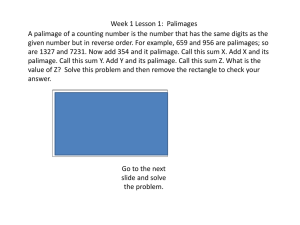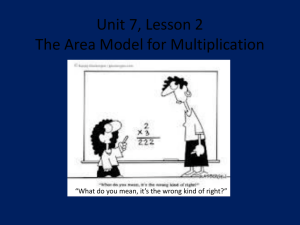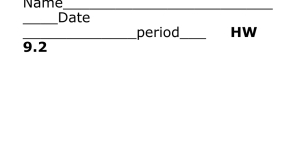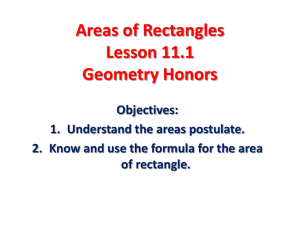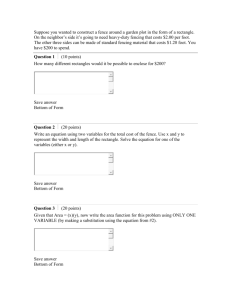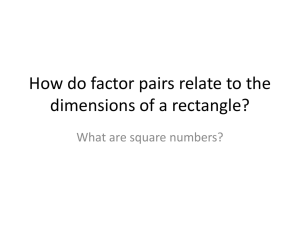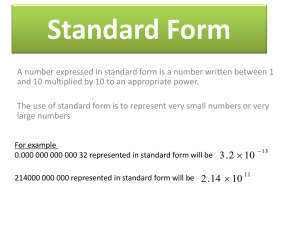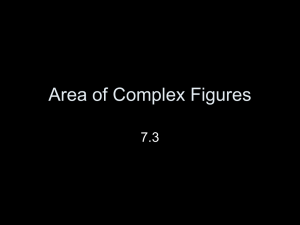Lesson 14 - The University of Toledo
advertisement
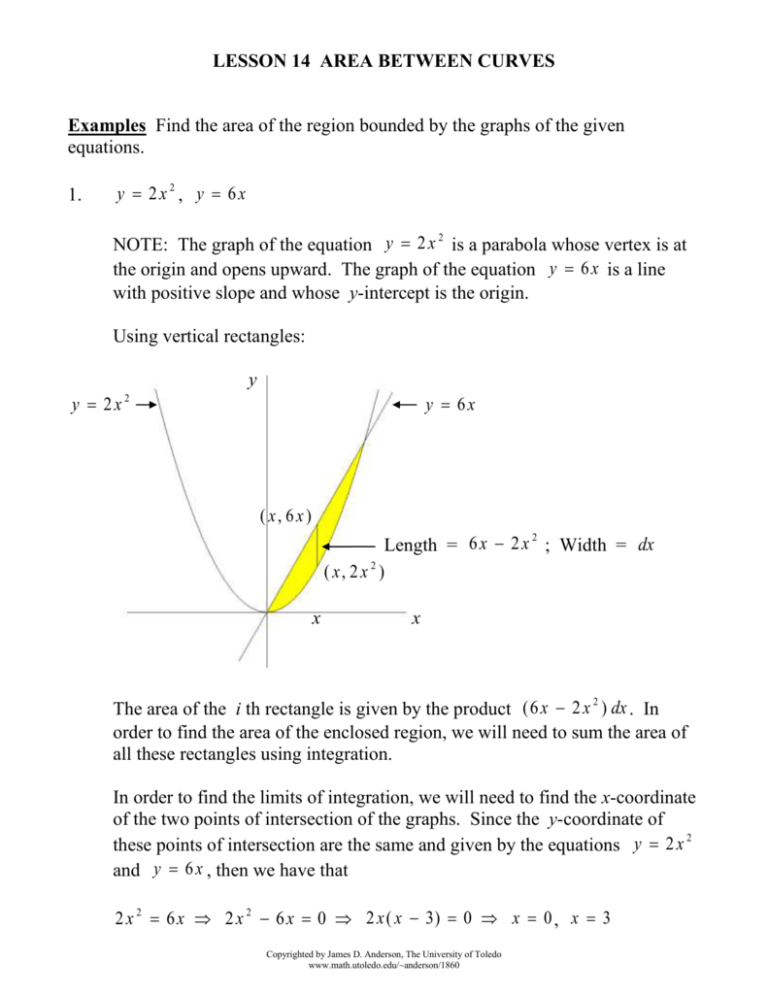
LESSON 14 AREA BETWEEN CURVES
Examples Find the area of the region bounded by the graphs of the given
equations.
1.
y 2x2 , y 6x
2
NOTE: The graph of the equation y 2 x is a parabola whose vertex is at
the origin and opens upward. The graph of the equation y 6 x is a line
with positive slope and whose y-intercept is the origin.
Using vertical rectangles:
y
y 2x2
y 6x
( x, 6 x)
2
Length = 6 x 2 x ; Width = dx
( x, 2 x 2 )
x
x
2
The area of the i th rectangle is given by the product ( 6 x 2 x ) dx . In
order to find the area of the enclosed region, we will need to sum the area of
all these rectangles using integration.
In order to find the limits of integration, we will need to find the x-coordinate
of the two points of intersection of the graphs. Since the y-coordinate of
2
these points of intersection are the same and given by the equations y 2 x
and y 6 x , then we have that
2 x 2 6 x 2 x 2 6 x 0 2 x ( x 3) 0 x 0 , x 3
Copyrighted by James D. Anderson, The University of Toledo
www.math.utoledo.edu/~anderson/1860
Thus, the first vertical rectangle in the region corresponds to when x 0 and
the last vertical rectangle in the region corresponds to when x 3 . Thus, we
sum from x 0 to x 3 . Thus, we obtain the following.
3
3
0
( 6 x 2 x 2 ) dx =
3
6x2 2x3
2x3
2
3x
2
3 0 =
3 0 =
27 18 ( 0 0 ) = 9
Using horizontal rectangles:
y
y 2x
y 6x
2
y
,y
6
y
y
, y
2
x
Length =
NOTE:
2
y 2x2 x
y 6x x
y
y
; Width = dy
2
6
y
x
2
y
2
y
6
Copyrighted by James D. Anderson, The University of Toledo
www.math.utoledo.edu/~anderson/1860
y
y
dy . In
The area of the i th rectangle is given by the product 2
6
order to find the area of the enclosed region, we will need to sum the area of
all these rectangles using integration.
In order to find the limits of integration, we will need to find the y-coordinate
of the two points of intersection of the graphs.
In the work above, we found that the x-coordinate of these points of
intersection were x 0 and x 3 . Then we can use the equation y 6 x
2
(or the equation y 2 x ) to find the y-coordinate of the points of
intersection. When x 0 , y 0 . When x 3 , y 6 ( 3 ) = 18.
Thus, the first horizontal rectangle in the region corresponds to when y 0
and the last horizontal rectangle in the region corresponds to when y 18 .
Thus, we sum from y 0 to y 18 . Thus, we obtain the following.
18
0
y
y
dy =
2
6
18
18
0
y
y
dy =
6
2
18
0
1 1/ 2 1
y y dy =
2
6
18
18
2 2 3/ 2
1 2 3/ 2 1 y 2
y2
1
1/ 2
y
y
y ( 4 2 y y )
6 2 =
6
12 = 12
2 3
0
0
0
=
18
(4 2
12
18 18 ) =
3
3
3
( 4 36 18 ) = [ 4 ( 6 ) 18 ] = [ 24 18 ] =
2
2
2
3
(6) = 9
2
Answer: 9
2.
x y 2 8 , 3x y 2
Copyrighted by James D. Anderson, The University of Toledo
www.math.utoledo.edu/~anderson/1860
2
2
NOTE: Since x y 8 x 8 y , then the graph of the equation
x y 2 8 is the graph of the equation x y 2 shifted eight units to the
2
left. The graph of the equation x y is a parabola whose vertex is at the
1 2
2
origin and opens to the right. Since 3 x y x y , then the
3
2
graph of the equation 3 x y is a parabola whose vertex is at the
origin and opens to the left.
Using horizontal rectangles:
x y2 8
y
1 2
y ,y
3
( y 2 8, y )
y
x
8
x
1 2
y
3
Length =
1 2
4
y ( y2 8) = 8 y2
3
3
Width = dy
4 2
The area of the i th rectangle is given by the product 8 y dy . In
3
order to find the area of the enclosed region, we will need to sum the area of
all these rectangles using integration.
In order to find the limits of integration, we will need to find the y-coordinate
of the two points of intersection of the graphs. Since the x-coordinate of
Copyrighted by James D. Anderson, The University of Toledo
www.math.utoledo.edu/~anderson/1860
these points of intersection are the same and given by the equations
1 2
x y 2 8 and x y , then we have that
3
y2 8
1 2
y 3 y 2 24 y 2 4 y 2 24 y 2 6 y 6
3
Thus, the first horizontal rectangle in the region corresponds to when
y 6 and the last horizontal rectangle in the region corresponds to
when y 6 . Thus, we sum from y 6 to y
obtain the following.
6
6
6 . Thus, we
4 2
8 y dy
3
Since the integrand of f ( y ) 8
4 2
y is an even function, then we may
3
write
6
6
4 2
8 y dy = 2 0
3
1 y3
8 2y
3 3 0
8
9
6 ( 18 6 ) =
6
4 2
8 y dy = 8 0
3
6
y3
= 8 2y 9
0
8
9
6 (12 ) =
8
3
6
6
1 2
2 y dy =
3
8
2
= 9 y ( 18 y )
0
6 (4) =
6
=
32 6
3
Using vertical rectangles:
x y2 8 y2 x 8
NOTE: The equation y
y
x 8 y
x8
x 8 is the top half of the parabola
x y 2 8 and the equation y
parabola.
x 8 is the bottom half of the
Copyrighted by James D. Anderson, The University of Toledo
www.math.utoledo.edu/~anderson/1860
x
1 2
y 3x y 2
3
NOTE: The equation y
y 2 3x
y
3x y 3x
3 x is the top half of the parabola x
1 2
y
3
and the equation y 3 x is the bottom half of the parabola.
y
3x
( x,
y
x 8)
Length = 2 x 8
8
x
( x, x 8 )
( x,
2
y
x8
3x )
Length = 2 3 x
x
x
( x, 3x )
y
x8
y 3x
Width = dx
NOTE: We found that the y-coordinates of the two points of intersection of
1 2
2
the equations x y 8 and x y were y 6 . Thus, the x3
2
coordinate of these points can be obtained using the equation x y 8 or
1 2
2
2
the equation x y . Using x y 8 , we have that x y 8 =
3
( 6 )2 8 = 6 8 2 .
To find the area of the yellow shaded region:
The area of the i th rectangle is given by the product 2 x 8 dx . In order
to find the area of the enclosed region, we will need to sum the area of all
these rectangles using integration.
Copyrighted by James D. Anderson, The University of Toledo
www.math.utoledo.edu/~anderson/1860
The first vertical rectangle in the yellow region corresponds to when x 8
and the last vertical rectangle in the yellow region corresponds to when
x 2 . Thus, we sum from x 8 to x 2 . Thus, we obtain the
following.
2
8
2
x 8 dx
Let u x 8
Then d u dx
2
8
6
2
x 8 dx = 2
0
u
4
3
3/ 2
6
6
0
=
6
u du = 2 u
0
1/ 2
2 3/ 2
du = 2 u =
3
0
4 3/ 2
4
( 6 0) = ( 6 6 ) = 8 6
3
3
Thus, the area of the yellow region, which is given by
2
8
2
x 8 dx , is
8 6.
To find the area of the aqua shaded region:
The area of the i th rectangle is given by the product 2 3 x dx . In order
to find the area of the enclosed region, we will need to sum the area of all
these rectangles using integration.
The first vertical rectangle in the yellow region corresponds to when x 2
and the last vertical rectangle in the yellow region corresponds to when
x 0 . Thus, we sum from x 2 to x 0 . Thus, we obtain the
following.
0
2
0
2
2 3 x dx
2 3 x dx =
0
2
2 3
x dx = 2 3
0
2
Copyrighted by James D. Anderson, The University of Toledo
www.math.utoledo.edu/~anderson/1860
x dx
Let u x
Then d u dx
2 3
0
x dx = 2 3
2
0
2
x ( 1) dx = 2 3
0
2
u du =
2
2 3
4 3
3
2
0
u du = 2 3
u
3/ 2
2
0
=
2
0
u
1/ 2
2 3/ 2
du = 2 3 u =
3
0
4 3
4 3
8 6
(2 2 ) =
( 2 3/ 2 0) =
3
3
3
Thus, the area of the aqua region, which is given by
0
2
2 3 x dx , is
8 6
.
3
Thus, the area of the enclosed region is given by
2
8
2
x 8 dx +
0
2
2 3 x dx = 8 6 +
24 6
8 6
8 6
=
+
=
3
3
3
32 6
3
Answer:
3.
y
32 6
3
5
2
3, x 1 , x 4
2 , y 4x
x
5
has the y-axis as a vertical
x2
5
asymptote and the x-axis as a horizontal asymptote. Since 2 is positive
x
NOTE: The graph of the equation y
Copyrighted by James D. Anderson, The University of Toledo
www.math.utoledo.edu/~anderson/1860
5
lies above the x-axis.
x2
2
2
Since y 4 x 3 y 3 4 x , then the graph of the equation
y 4 x 2 3 is the graph of the equation y 4 x 2 shifted three units
for all x 0 , then the graph of the equation y
2
downward. The graph of the equation y 4 x is a parabola whose vertex
is at the origin and opens downward. The graph of the equation x 1 is a
vertical line which crosses the x-axis at 1. The graph of the equation x 4
is a vertical line which crosses the x-axis at 4.
y
y
5
x2
5
x, 2
x
1
x
4
x
( x , 4 x 2 3)
Length =
5
5
( 4 x 2 3) = 2 4 x 2 3
2
x
x
Width = dx
y 4x2 3
x 1
x 4
5
2
The area of the i th rectangle is given by the product 2 4 x 3 dx .
x
In order to find the area of the enclosed region, we will need to sum the area
of all these rectangles using integration.
The first vertical rectangle in the region corresponds to when x 1 and the
last vertical rectangle in the region corresponds to when x 4 . Thus, we
sum from x 1 to x 4 . Thus, we obtain the following.
4
1
5
2
2 4 x 3 dx =
x
4
1
( 5 x 2 4 x 2 3 ) dx =
Copyrighted by James D. Anderson, The University of Toledo
www.math.utoledo.edu/~anderson/1860
4
4
5x 1
4x3
5
4x3
3x =
3x =
1
3
x
3
1
1
5 256
4
5
256
4
12 5 3 =
12 2
=
4
3
3
4
3
3
5
252
5
5
5
392
387
14 = 84 14 = 98 =
=
4
3
4
4
4
4
4
Answer:
4.
x
387
4
1 2
y 4 y , x 16 3 y
2
1 2
y 4 y is a parabola that opens
2
to the right from its vertex. We need to find the coordinates of this vertex.
1 2
1
Since x y 4 y x y ( y 8 ) , then the y-coordinates of the y2
2
intercepts of the graph of the parabola are y 0 and y 8 . Thus, the
axis of symmetry for the parabola is the horizontal line y 4 . Since the
vertex of the parabola lies on this axis of symmetry, then the y-coordinate of
1
x
y ( y 8 ) , then we can find the xy
4
the vertex is
. Since
2
1
1
coordinate for the vertex by x ( 4 ) ( 4 8 ) = ( 4 ) ( 4 ) = 8 .
2
2
Thus, the vertex of the parabola is ( 8 , 4 ) . The graph of the equation
x 16 3 y is a line.
NOTE: The graph of the equation x
Using horizontal rectangles:
Copyrighted by James D. Anderson, The University of Toledo
www.math.utoledo.edu/~anderson/1860
x 16 3 y
y
x
1 2
y 4y
2
x
1 2
y 4 y, y
2
y
(16 3 y , y )
1 2
1 2
Length = 16 3 y y 4 y = 16 7 y y
2
2
Width = dy
1 2
The area of the i th rectangle is given by the product 16 7 y y dy .
2
In order to find the area of the enclosed region, we will need to sum the area
of all these rectangles using integration.
In order to find the limits of integration, we will need to find the y-coordinate
of the two points of intersection of the graphs. Since the x-coordinate of
these points of intersection are the same and given by the equations
1
x y 2 4 y and x 16 3 y , then we have that
2
1 2
y 4 y 16 3 y y 2 8 y 32 6 y y 2 14 y 32 0
2
( y 16 ) ( y 2 ) 0 y 16 , y 2
Thus, the first horizontal rectangle in the region corresponds to when
y 16 and the last horizontal rectangle in the region corresponds to when
y 2 . Thus, we sum from y 16 to y 2 . Thus, we obtain the
following.
Copyrighted by James D. Anderson, The University of Toledo
www.math.utoledo.edu/~anderson/1860
2
2
16
7y 2 1 y 3
1 2
16 7 y y dy = 16 y
2
2 3 16 =
2
2
7y 2
y3
1
16 y
=
2
6 16
6
y ( 96 21 y y )
2
2
16
=
1
{ 2 ( 96 42 4 ) 16 [ 96 21(16 ) (16 ) (16 ) ] } =
6
1
1
[ 2 ( 50 ) 16 (16 ) ( 6 21 16 ) ] = [ 100 16 (16 ) (11) ] =
6
6
1
2
2
2
( 4 ) [ 25 4 (16 ) (11) ] = [ 25 64 (11) ] = ( 25 704 ) = ( 729 ) =
6
3
3
3
2
( 243 ) = 486
1
Using vertical rectangles:
x
1 2
y 4 y 2 x y 2 8 y 2 x 16 y 2 8 y 16
2
2 x 16 ( y 4 ) 2
y 4
2 x 16 y 4 2 x 16
y 4 2 x 16
NOTE: The equation y 4 2 x 16 is the top half of the parabola
1
x y 2 4 y and the equation y 4 2 x 16 is the bottom half of
2
the parabola.
x 16 3 y 3 y 16 x y
1
( 16 x )
3
Copyrighted by James D. Anderson, The University of Toledo
www.math.utoledo.edu/~anderson/1860
y
1
( 16 x )
3
y
y 4 2 x 16
x
( 10 , 2 )
x
x
1
x , ( 16 x )
3
( x , 4 2 x 16 )
( 8, 4 )
( x , 4 2 x 16 )
( x , 4 2 x 16 )
( 64 , 16 )
y 4 2 x 16
The length of the vertical rectangle in the yellow shaded region is given by
4 2 x 16 ( 4 2 x 16 ) = 4 2 x 16 4 2 x 16 =
2 2 x 16 .
The length of the vertical rectangle in the aqua shaded region is given by
1
1
( 16 x ) ( 4 2 x 16 ) =
( 16 x ) 4 2 x 16 .
3
3
The width of each vertical rectangle is dx .
NOTE: We found that the y-coordinates of the two points of intersection of
1 2
the equations x y 4 y and x 16 3 y were y 16 and y 2 .
2
Thus, the x-coordinate of these points can be obtained using the equation
1
x y 2 4 y or the equation x 16 3 y . Using x 16 3 y , we have
2
that x 16 3 y = 16 48 64 when y 16 and x 16 3 y =
16 6 10 when y 2 .
To find the area of the yellow shaded region:
Copyrighted by James D. Anderson, The University of Toledo
www.math.utoledo.edu/~anderson/1860
The area of the i th rectangle is given by the product 2 2 x 16 dx . In
order to find the area of the enclosed region, we will need to sum the area of
all these rectangles using integration.
The first vertical rectangle in the yellow region corresponds to when x 8
and the last vertical rectangle in the yellow region corresponds to when
x 10 . Thus, we sum from x 8 to x 10 . Thus, we obtain the
following.
10
8
2 2 x 16 dx =
10
8
2 2 x 8 dx
Let u x 8
Then d u dx
10
8
2 2 x 8 dx = 2 2
18
2
4 2
2 2 u 3/ 2 =
3
3
0
18
0
u
3/ 2
u du = 2 2
18
0
=
18
0
u 1/ 2 du =
4 2
4 2
( 18 3 / 2 0 ) =
( 18 18 ) =
3
3
4 2
( 6 18 ) 24 36 24 ( 6 ) 144
1
Thus, the area of the yellow region, which is given by
10
8
2 2 x 16 dx , is
144.
To find the area of the aqua shaded region:
The area of the i th rectangle is given by the product
1
3 ( 16 x ) 4 2 x 16 dx . In order to find the area of the enclosed
region, we will need to sum the area of all these rectangles using integration.
Copyrighted by James D. Anderson, The University of Toledo
www.math.utoledo.edu/~anderson/1860
The first vertical rectangle in the yellow region corresponds to when x 10
and the last vertical rectangle in the yellow region corresponds to when
x 64 . Thus, we sum from x 10 to x 64 . Thus, we obtain the
following.
64
10
64
10
1
(
16
x
)
4
2
x
16
3
dx =
1
3 ( 16 x ) 4
1 (16 x ) 2
4x
3
2
2
x 8 dx =
64
2
2 ( x 8) 3/ 2 =
3
10
2 2
1
(16 x ) 2 4 x
( x 8) 3/ 2
6
3
64
=
10
1
2 2
2 2
1
( 48 ) 2 256
( 72 ) 3 / 2 ( 6 ) 2 40
(18 ) 3 / 2 =
6
3
3
6
2 2
2 2
1
( 48 ) ( 48 ) 256
72 72 6 40
18 18 =
6
3
3
8 ( 48 ) 222 2 2 24 6 2 2 2 6 3 2 =
384 222 48 6 2 36 2 = 162 12 3 2 ( 4 2 1 1 ) =
162 72 ( 7 ) = 162 504 342
Thus, the area of the aqua region, which is given by
64 1
10 3 ( 16 x ) 4 2 x 16 dx , is 342.
Thus, the area of the enclosed region is given by
Copyrighted by James D. Anderson, The University of Toledo
www.math.utoledo.edu/~anderson/1860
10
8
2 2 x 16 dx +
64
10
1
3 ( 16 x ) 4 2 x 16 dx = 144 + 342 =
486
Answer: 486
5.
y cos 2 x , y e x / 4 , x 0 , x
2
NOTE: The graph of the equation y cos 2 x has an amplitude of 1 and a
period of . The graph of the equation x 0 is the y-axis. The graph of
the equation x
is a vertical line which crosses the x-axis at .
2
2
y
y e x/4
( x, e x/4 )
x/4
Length = e cos 2 x ; Width = dx
x
( x , cos 2 x )
y cos 2 x
x
2
x/4
The area of the i th rectangle is given by the product ( e cos 2 x ) dx . In
order to find the area of the enclosed region, we will need to sum the area of
all these rectangles using integration.
Copyrighted by James D. Anderson, The University of Toledo
www.math.utoledo.edu/~anderson/1860
The first vertical rectangle in the region corresponds to when x 0 and the
last vertical rectangle in the region corresponds to when x . Thus, we
2
sum from x 0 to x . Thus, we obtain the following.
2
/2
0
/2
( e x / 4 cos 2 x ) dx = 4 e
4 e /8
x/4
1
sin 2 x
2
0
=
1
1
sin 4 sin 0 = 4 e / 8 4 = 4 ( e / 8 1 )
2
2
NOTE: sin 0 sin 0
/8
1)
Answer: 4 ( e
6.
y
x , y 4, x 0
NOTE: Since y
x y 2 x x y 2 , then the graph of the
equation y x is the top half of the parabola whose vertex is at the
origin and opens to the left. The graph of the equation y 4 is a horizontal
line which crosses the y-axis at 4. The graph of the equation x 0 is the
y-axis.
Using vertical rectangles:
y
x
( x, 4)
y
4
Length = 4
( x, x )
16
x
x
Copyrighted by James D. Anderson, The University of Toledo
www.math.utoledo.edu/~anderson/1860
x ; Width = dx
The area of the i th rectangle is given by the product ( 4 x ) dx . In
order to find the area of the enclosed region, we will need to sum the area of
all these rectangles using integration.
Since the last vertical rectangle in the region corresponds to when x 0 , the
upper limit of integration is x 0 . In order to find the lower limit of
integration, we will need to find the x-coordinate of the point of intersection
of the graphs of y x and y 4 . Thus, we have that
x 4 x 16 x 16
Thus, the lower limit of integration is x 16 . Thus, the first vertical
rectangle in the region corresponds to when x 16 . Thus, we sum from
x 16 to x 0 . Thus, we obtain the following.
0
16
(4
x ) dx
Let u x
Then u dx
0
16
16
0
(4
(4
0
x ) dx = ( 4
16
u ) du =
16
0
0
x ) ( 1) dx = ( 4
16
( 4 u 1 / 2 ) du =
16
0
( 4 u 1 / 2 ) du =
16
2
2
2
4 u u 3 / 2 = 64 16 3 / 2 ( 0 0 ) = 64 ( 64 ) =
3
3
3
0
2
64
1
64 1 = 64 =
3
3
3
Using horizontal rectangles:
Copyrighted by James D. Anderson, The University of Toledo
www.math.utoledo.edu/~anderson/1860
u ) du =
y
x
y
4
( y 2 , y)
( 0, y )
16
x
2
2
Length = 0 ( y ) = y ; Width = dy
NOTE:
y
x y2 x x y2
2
The area of the i th rectangle is given by the product y dy . In order to find
the area of the enclosed region, we will need to sum the area of all these
rectangles using integration.
Thus, the first horizontal rectangle in the region corresponds to when y 0
and the last horizontal rectangle in the region corresponds to when y 4 .
Thus, we sum from y 0 to y 4 . Thus, we obtain the following.
4
4
0
y3
1 3
2
y
y dy =
=
3 0
3
Answer:
4
0
=
1
64
( 64 0 ) =
3
3
64
3
Copyrighted by James D. Anderson, The University of Toledo
www.math.utoledo.edu/~anderson/1860
